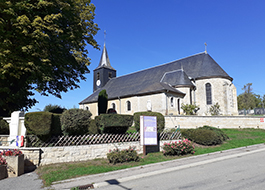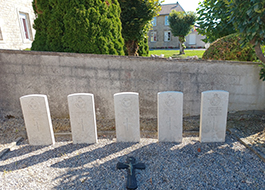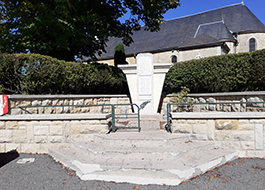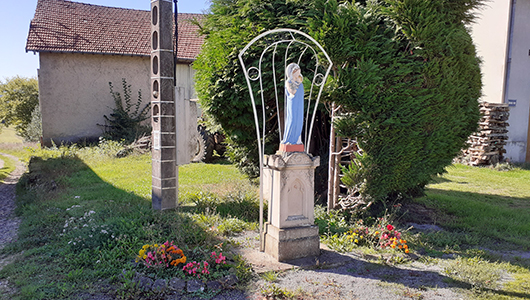Beaufort-en-Argonne
Durée visite : 30 minutes
Moyen : Pédestre
Le village est une ancienne paroisse du diocèse de Reims. Il est connu pour avoir adopté dès 1188 la loi de Beaumont, qui accordait une large autonomie aux habitants. C’est la première commune à en bénéficier dans la région. Beaufort-en-Argonne dispose d’une forteresse au XIIe siècle. Au XVIe, une maison forte avec souterrains sert d’abri aux habitants. Une forge a fonctionné ici au XIXe, de même qu’une tuilerie, un moulin et une huilerie. L’architecture en pans de bois et torchis, favorisé par la présence d’une grande forêt, a progressivement disparu.
The village is a former parish of the diocese of Reims. He is known to have adopted as early as 1188 the law of Beaumont, which granted a large autonomy to the inhabitants. It is the first municipality to benefit from it in the region. Beaufort-en-Argonne has a 12th century fortress. A forge operated here in the 19th century, as well as a tile factory, a mill and an oil mill. The half-timbered and cob architecture, favored by the presence of a large forest, has gradually disappeared.
Das Dorf ist eine ehemalige Pfarrei der Diözese Reims. Es ist bekannt, dass er bereits 1188 das Gesetz von Beaumont verabschiedete, das den Einwohnern eine große Autonomie einräumte. Sie ist die erste Kommune in der Region, die davon profitiert. Beaufort-en-Argonne hat eine Festung aus dem 12. Jahrhundert. Im 19. Jahrhundert wurde hier eine Schmiede betrieben, außerdem eine Ziegelei, eine Mühle und eine Ölmühle. Die Fachwerk- und Lehmbauweise, begünstigt durch die Anwesenheit eines großen Waldes, ist allmählich verschwunden.

D’azur à la tour carrée aux contreforts d’argent, ajourée du champ, maçonnée de sable, essorée de gueules et accostée de deux feuilles d’alisier torminal inclinées et adossées d’or; au chef parti, au I), de gueules à une roue de Sainte Catherine d’or, le quart chef-senestre manquant; au II) d’or, chargé de deux clous de gueules passés en sautoir.
Création Robert A. LOUIS et Dominique LACORDE adoptée le 07 septembre 2021
Azure to the square tower with buttresses Argent, openwork of the field, masonry Sable, wrung Gules and accosted of two leaves of alisier torminal inclined and backed Or; a chief parti, I), Gules a wheel of Saint Catherine Or, the quarter chief sinister missing; II) Or, charged with two nails Gules in saltire.
Creation Robert A. LOUIS and Dominique LACORDE adopted on September 07, 2021
Azurblau zum quadratischen Turm mit Strebepfeilern Argent, durchbrochenes Feld, Mauerwerk Sable, gewundene Gules und angeredet von zwei tominalen Alisier-Blättern, die geneigt und gesichert sind, oder; ein Hauptparti, I), Gules, ein Rad der Heiligen Katharina oder, das Viertel des Hauptfinsternis fehlt; II) Oder, aufgeladen mit zwei Nägeln Gules in Saltire.
Kreation Robert A. LOUIS und Dominique LACORDE verabschiedet am 07. September 2021
Les points de visites

.
L’ancienne église est incendiée par les Huguenots en 1570. Le bâtiment actuel est reconstruit au XVIIIe siècle. Il possède un chœur de 1910. Le mobilier proviendrait de l’ancienne chartreuse du Mont-Dieu, dans les Ardennes. Un globe surmonté d’une croix, symbole de l’Ordre des chartreux, se trouve d’ailleurs à l’entrée de l’église. La guerre de 1914 endommage l’édifice. Sainte Catherine d’Alexandrie est une des plus célèbres martyres des premiers siècles. Après avoir converti une cinquantaine de philosophes païens, elle fut introduite dans une machine infernale, composée de roues armées de pointes tournant en sens inverse.
Ses restes furent alors emportés par les anges sur le Mont Sinaï. Là fut construit un monastère en son honneur.
The old church was burned down by the Huguenots in 1570. The current building was rebuilt in the 18th century. It has a choir from 1910. The furniture would come from the former Charterhouse of Mont-Dieu, in the Ardennes. A globe surmounted by a cross, symbol of the Carthusian order, is also at the entrance to the church. The 1914 war damaged the building. Saint Catherine of Alexandria is one of the most famous Martyrs of the first centuries. After having converted about fifty pagan philosophers, she was introduced into an infernal machine, composed of wheels armed with spikes rotating in the opposite direction. His remains were then carried away by angels to Mount Sinai. There a monastery was built in his honor.
Die alte Kirche wurde 1570 von den Hugenotten niedergebrannt. Das heutige Gebäude wurde im 18. Jahrhundert wieder aufgebaut. Es hat einen Chor von 1910. Die Möbel stammen aus der ehemaligen Kartause von Mont-Dieu in den Ardennen. Am Eingang der Kirche befindet sich auch eine von einem Kreuz gekrönte Weltkugel, Symbol des Kartäuserordens. Der Krieg von 1914 beschädigte das Gebäude. Die heilige Katharina von Alexandria ist eine der berühmtesten Märtyrerinnen der ersten Jahrhunderte. Nachdem sie etwa fünfzig heidnische Philosophen bekehrt hatte, wurde sie in eine höllische Maschine eingeführt, die aus Rädern bestand, die mit Stacheln bewaffnet waren, die sich in die entgegengesetzte Richtung drehten.
Seine sterblichen Überreste wurden dann von Engeln zum Berg Sinai getragen. Dort wurde ihm zu Ehren ein Kloster errichtet.

.
Cinq aviateurs anglais sont inhumés dans le cimetière. Leur avion a été abattu le 21 décembre 1942. L’officier pilote Cooke était originaire de la Rhodésie du Sud. Leur bombardier quadrimoteur, un Avro 683 Lancaster, est entré en service en 1942. Principal bombardier de la Royal Air Force avec le Handley Page Halifax, il a été produit à 7000 exemplaires. Le Bomber Command a compté 50 000 appareils. Ils ont effectué 350 000 sorties. 1,4 million de tonnes de bombes ont été larguées. 9000 avions ont été abattus, 50 000 aviateurs tués.
Le lieu abrite aussi les tombes du lieutenant Pilardeau et du capitaine Steff, deux officiers français du 120e régiment d’Infanterie, morts en 1914.
Five English airmen are buried in the cemetery. Their plane was shot down on December 21, 1942. Pilot Officer Cooke was from Southern Rhodesia. Their four-engined bomber, an Avro 683 Lancaster, entered service in 1942. Main bomber of the Royal Air Force with the Handley Page Halifax, it was produced in 7000 copies.
The place also houses the graves of Lieutenant Pilardeau and Captain Steff, two French officers of the 120th Infantry Regiment, who died in 1914.
Auf dem Friedhof sind fünf englische Flieger begraben. Ihr Flugzeug wurde am 21. Dezember 1942 abgeschossen. Pilot Officer Cooke stammte aus Südrhodesien. Ihr viermotoriger Bomber, eine Avro 683 Lancaster, wurde 1942 in Dienst gestellt. Hauptbomber der Royal Air Force mit der Handley Page Halifax, es wurde in 7000 Exemplaren hergestellt. Der Ort beherbergt auch die Gräber von Leutnant Pilardeau und Hauptmann Steff, zwei französische Offiziere des 120. Infanterieregiments, die 1914 starben.

.
Cette plaque remplace l’ancien monument de 1920. Le nom du lieutenant Pilardeau y figure, bien qu’originaire de la Marne. Il est tombé à Beaufort en août 1914. Les combats y furent féroces. Relatons une anecdote.
Un colonel allemand, logeant chez un habitant, a fait le 31 août ses adieux en lui disant « Au revoir, Monsieur. Dans huit jours, nous sommes à Paris » Le 14 septembre, il était de retour à Beaufort dans la même chambre « Je vous croyais à Paris, lui a dit l’hôte. Vous battez donc en retraite ? » Le colonel répondit «Nous faisons un petit mouvement de recul» Au même instant deux grosses larmes ont coulé de ses yeux et il a ajouté «Monsieur, Allemagne, perdue»
This plate replaces the old monument of 1920. The name of Lieutenant Pilardeau appears there, although originating from the Marne. He fell at Beaufort in August 1914. The fighting there was fierce. Let’s tell an anecdote. A German colonel, staying with an inhabitant, said his farewells on August 31, saying “Goodbye, Sir. In eight days, we are in Paris » On September 14, he was back in Beaufort in the same room. « I thought you were in Paris, » the host told him. So you’re retreating? « We’re taking a step back, » replied the Colonel. At the same moment two big tears fell from his eyes and he added “Sir, Germany, lost! »
Dieses Schild ersetzt das alte Denkmal von 1920. Der Name von Leutnant Pilardeau erscheint dort, obwohl er von der Marne stammt. Er fiel im August 1914 bei Beaufort. Die Kämpfe dort waren heftig. Erzählen wir eine Anekdote.
Ein deutscher Oberst, der bei einem Einwohner wohnte, verabschiedete sich am 31. August mit den Worten: „Auf Wiedersehen, Sir. In acht Tagen sind wir in Paris » Am 14. September war er wieder in Beaufort im selben Zimmer. „Ich dachte, Sie wären in Paris“, sagte der Gastgeber zu ihm. Du ziehst dich also zurück? „Wir treten einen Schritt zurück“, erwiderte der Colonel. Im selben Moment kullerten zwei große Tränen aus seinen Augen und er fügte hinzu: „Sir, Deutschland, verloren! »





